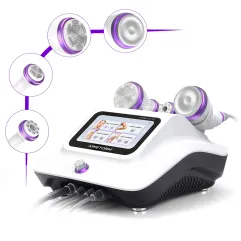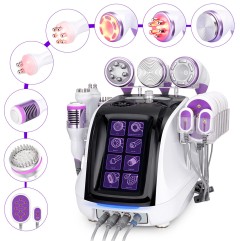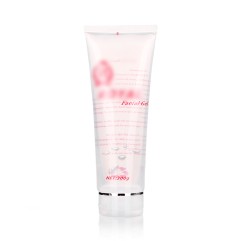Is there any risk associated with ultrasonic cavitation? Can there be damage to organs? Is ultrasonic cavitation safe? Is ultrasonic cavitation dangerous? Can ultrasonic cavitation cause cancer?
Many people have questions about ultrasonic cavitation, yet what is the truth? In this article from myChway, let's answer together.
I will show you the following:
- 1. Does ultrasonic cavitation have any side effect on health?
- 2. Under what circumstances can the machine be used?
- 3. Under what circumstances is it not possible?
- 4. What are the risks you will face when misusing it?
- 5. Why are there these risks?
- 6. How to use an ultrasound cavitation machine safely?
- 7. Precautions for using the ultrasonic cavitation machine?
- 8. Precautions after ultrasound cavitation treatment?
First of all, it is clear that when used correctly, ultrasonic cavitation has no side effects for most people. Cavitation is an advanced cosmetology device that uses ultrasonic sound waves to break down stubborn fat cells quickly and easily. It's a safe, effective, and non-surgical way to achieve a slimmer, more toned figure without downtime or discomfort - experience fast and painless body sculpting with Ultrasonic Cavitation Machine. Achieve the body you’ve always wanted.
A lot of risks on the internet about ultrasonic cavitation are mostly explained about the risks of ultrasonic liposuction. An ultrasonic cavitation machine is an ultrasonic wave that acts externally and is safe without side effects according to the instructions and can be used correctly to achieve good results. While ultrasonic liposuction is a surgical procedure with tiny incisions and is prone to complications such as blood clots, seromas, etc. (The treatment is less risky compared to traditional liposuction.)
Does Ultrasonic Cavitation Have Any Side Effects on Health?
Ultrasonic cavitation fat removal is an FDA-approved procedure. Global statistics released in 2018 by the American Society of Aesthetic Plastic Surgery show that non-invasive techniques for fat reduction are gaining more traction than surgical procedures.
To answer the question, we asked at the beginning, can it cause cancer? Does it cause damage to organs? Does ultrasonic cavitation have an effect? The answer is, no, no, yes.
1.1 Can ultrasonic cavitation cause cancer?
Currently, no scientific evidence suggests that ultrasonic cavitation can cause cancer. This blog has more details on the clinical studies of ultrasonic cavitation therapy.
Cancer is generally is caused by genetic mutations and exposure to carcinogenic substances or radiation. While ultrasound waves can generate heat and pressure, the energy levels used in ultrasonic cavitation treatments are considered safe and incapable of causing cancer.

1.2 Does ultrasound cavitation damage organs?
The ultrasound waves used in the procedure are not powerful enough to damage organs directly, and there is a risk of tissue damage if the treatment is performed incorrectly or at too high of an intensity. Ultrasonic cavitation is a non-invasive cosmetic treatment, it is generally considered to be a safe procedure when performed with correct use. This ultrasonic cavitation warning is not valid.
1.3 Is ultrasonic cavitation effective?
There is some evidence to suggest that ultrasonic cavitation may be an effective treatment for reducing the appearance of cellulite and localized fat deposits. Studies have shown that ultrasonic cavitation can lead to a reduction in circumference measurements and improvements in skin texture and appearance.

Who Can Use Ultrasonic Cavitation?
Generally, individuals who are in good overall health and have localized areas of fat or cellulite may be suitable candidates for ultrasonic cavitation.
When Should Ultrasonic Cavitation Be Avoided?
However, certain factors may make a person unsuitable for the treatment. Here are some ultrasonic cavitation warnings to be aware of including:
Pregnancy: Ultrasonic cavitation is not recommended for pregnant women due to the potential risks to the developing fetus.
Breastfeeding: The safety of ultrasonic cavitation during breastfeeding is not well established, so it's recommended to avoid the treatment until after the breastfeeding period.
Medical conditions: Individuals with certain medical conditions, such as liver or kidney disease, should avoid ultrasonic cavitation, which may place additional stress on these organs.
Metal implants: The treatment should not be performed on areas of the body with metal implants, as the ultrasound waves can cause discomfort or damage.
Common Mistakes to Avoid When Using an Ultrasonic Cavitation Machine
There are several behaviors that could be considered incorrect use of an ultrasonic cavitation machine, including:
Using the machine on broken or irritated skin: Ultrasonic cavitation should not be used on areas of the skin that are broken, irritated, or infected, as this can increase the risk of infection or tissue damage.
Applying the ultrasound waves too aggressively: The ultrasound waves should be applied in a gentle and controlled manner, and should not be used at too high of intensity or for too long.
Focusing the ultrasound waves too closely on a small area: The ultrasound waves should be spread out evenly over the treatment area, and not too closely on a small area.
What are the Ultrasonic Cavitation Risks You Will Face When Misusing It?
Improper use of an ultrasonic cavitation machine can lead to potential risks and complications, including:
Burns: Ultrasonic cavitation can cause burns if the ultrasound waves are applied at too high of intensity or if the device is left in one area for too long. Although the energy of the home device is set at a low level, the same care must be taken not to overuse it.
Skin damage: The ultrasound waves can damage the skin if the device is applied too aggressively or if the skin is too thin or sensitive.
Tissue damage: The ultrasound waves can cause damage to underlying tissues, such as muscle or connective tissue if the device is too high of an intensity.
Pain or discomfort: Improper use of the device can cause pain or discomfort during treatment, which may persist after treatment.
Nerve damage: The ultrasound waves can damage nerves if the device is applied too high, which can result in numbness, tingling, or loss of sensation in the affected area.
Ineffective treatment: Improper use of the device can lead to ineffective treatment, meaning the desired results may not be achieved.
If you experience any unusual symptoms or complications after undergoing ultrasonic cavitation, it's important to seek medical attention immediately.
Why are risks associated with cavitation treatment?
The risks associated with improper use of an ultrasonic cavitation machine are mainly due to the high frequency and intensity of the ultrasound waves used in the treatment. These waves can penetrate the skin and cause mechanical disruption of the fat cells, leading to the release of their contents into the surrounding tissue, where the body can metabolize them.
If the ultrasound waves are applied too aggressively or at too high of an intensity, they can also cause damage to the surrounding tissues, including the skin, muscles, nerves, and internal organs. In addition, if the ultrasound waves are focused too closely on a small area, they can generate excessive heat, leading to burns or tissue damage.
How to use an ultrasound cavitation machine safely?
The machine should only be used under specific circumstances, as outlined below:
A trained person should use the machine: You can buy cavitation machines for home use but read the instructions carefully before using them to ensure you already know how to use them. If you go to an aesthetic center for treatment, ensure your therapist is licensed.
The machine should be used on specific areas of the body: Ultrasonic cavitation is most commonly used on areas of the body with localized fat deposits, such as the thighs, hips, and abdomen.
The machine should be used at appropriate energy levels: The intensity of the ultrasound waves should be adjusted according to the thickness of the fat layer and the sensitivity of the skin to avoid causing tissue damage. The energy level of the home device has been set to a low level.
In this video, we’ll show you how to use an 80k cavitation machine on the belly, a professional operating in a SPA center.
Next, I will show a video of how to use the ultrasonic cavitation machine at home on your belly by yourself
Which body parts are best suited for ultrasonic cavitation?
Ultrasonic cavitation can be used on various parts of the body to help reduce the appearance of cellulite and contour the body. The most commonly treated areas include:
Abdomen: Ultrasonic cavitation can help reduce belly fat and contour the stomach area.
Thighs: The treatment can be used to target stubborn fat in the inner and outer thighs.
Buttocks: Ultrasonic cavitation can help lift and contour the buttocks.
Arms: The treatment can be used to target fat on the upper arms and reduce the appearance of "bat wings."
Back: Ultrasonic cavitation can help reduce back fat and contour the area.
Love handles: The treatment can help target and reduce stubborn fat around the waistline.
It's also important to consult with a qualified practitioner to determine if you are a good candidate for the treatment.

How long is the interval between the use of the ultrasonic cavitation machine?
Generally, it is recommended to wait at least 48 hours between each treatment session to allow the body time to metabolize the fat and eliminate the waste products. The recommended interval between using ultrasonic cavitation machines can vary depending on the specific treatment and the individual's response to the treatment.
How long does a course of ultrasonic cavitation last?
Generally, a course of ultrasonic cavitation may involve multiple treatment sessions scheduled over several weeks or months.
The number of sessions needed may vary depending on factors such as the individual's starting weight and body composition, the areas being treated, and the desired results. In some cases, a course of treatment may involve 6-10 sessions, while in other cases it may involve more or fewer sessions. Each treatment takes about half an hour or an hour, depending on the physical condition of each individual.
Frequency of use of home cavitation machines, in the first month,2~3 times for the first two weeks and once for the following two weeks. Then once a week is recommended from the second month, no more than 30 minutes each time.
Preparation before ultrasonic cavitation treatment
To prepare for ultrasonic cavitation treatment, here are some recommended steps:
Hydration: Drink plenty of water before the treatment to ensure proper hydration, which can help improve the effectiveness of the treatment and reduce the risk of side effects.
Avoid caffeine and alcohol: Avoid consuming caffeine and alcohol for at least 24 hours before the treatment, as they can dehydrate the body and reduce the effectiveness of the treatment.
Avoid heavy meals: Avoid eating a heavy meal before the treatment, as this can cause discomfort during the treatment.
Wear comfortable clothing: Wear comfortable and loose-fitting clothing to the treatment to ensure you are comfortable during the treatment.
Remove jewelry: Remove any jewelry or metal objects from the area being treated, as they can interfere with the treatment.
What is the best frequency to use an ultrasonic cavitation machine?
Generally, frequencies between 30 and 80 kHz are used for body contouring and fat reduction. Lower frequency cavitation machines such as 40kHz may be better suited for larger areas or areas with more stubborn fat, as they provide deeper penetration and target a wider range of tissues. On the other hand, higher frequency cavitation machines such as 60kHz or 80kHz may be better suited for smaller areas or more delicate areas of the body, as they provide more superficial treatment and are less likely to cause discomfort.
How to choose a suitable ultrasonic cavitation machine if you use it yourself at home?
Choosing a suitable ultrasonic cavitation machine for home use requires careful consideration of several factors, including:
Power: The machine should be powerful enough to deliver effective results, but not so powerful that it causes harm or discomfort. Look for a machine with a power output of between 30W and 50W.
Frequency: The machine should operate at a frequency between 25 kHz and 45 kHz, which is optimal for body contouring and fat reduction.
Safety features: Look for a machine with safety features such as automatic shut-off if the machine overheats or exceeds the recommended treatment time.
Ease of use: Choose a machine that is easy to operate and comes with clear instructions and guidance on how to use it safely and effectively.
Price: Consider the price of the machine, but do not compromise on quality and safety.
Brand reputation: Choose a machine from a reputable brand with a track record of producing high-quality and safe machines.
While ultrasonic cavitation machines can be used at home, to receive guidance on how to use them safely and effectively.
How to select a qualified ultrasonic cavitation therapy spa center?
Selecting a qualified ultrasonic cavitation therapy spa center can help ensure that you receive safe and effective treatment. Here are some factors to consider when selecting a spa center:
Credentials and qualifications: Look for a spa center with licensed and experienced practitioners who have received training and certification in ultrasonic cavitation therapy.
Safety protocols: Check if the spa center follows proper safety protocols such as providing protective eyewear and monitoring the machine’s temperature during treatment.
Equipment quality: Choose a spa center that uses high-quality and well-maintained equipment to ensure safe and effective treatment.
Reputation: Check online reviews for ultrasonic cavitation machines and ratings from past customers to gauge the reputation of the spa center and the effectiveness of their treatments.
Customer service: Choose a spa center with friendly and knowledgeable staff who can answer any questions you may have and provide guidance on post-treatment care.
Treatment plans: Choose a spa center that offers customized treatment plans based on your individual needs and goals.
Pricing: Compare the pricing of different spa centers, but do not compromise on quality and safety.
Precautions after ultrasonic cavitation treatment
After an ultrasound treatment, here are some recommended precautions:
Hydration: Drink plenty of water after the treatment to help flush out the toxins released during the treatment and to ensure proper hydration.
Avoid caffeine and alcohol: Avoid consuming caffeine and alcohol for at least 24 hours after the treatment, as they can dehydrate the body and interfere with eliminating toxins.
Avoid heavy meals: Avoid eating a heavy meal immediately after the treatment, as this can cause discomfort and may interfere with eliminating toxins.
Avoid strenuous exercise: Avoid strenuous exercise for at least 24 hours after the treatment, as this can cause discomfort and may interfere with the effectiveness of the treatment.
Avoid hot baths or saunas: Avoid hot baths, saunas, or other heat treatments for at least 24 hours after the treatment, as this can cause discomfort and may interfere with the effectiveness of the treatment.
You may like
-

Brand: ARISTORM
ARISTORM S Shape Cavitation Machine Body Slimming Skin Firming Facial Lifting for Home Use
$459.00
-

-



